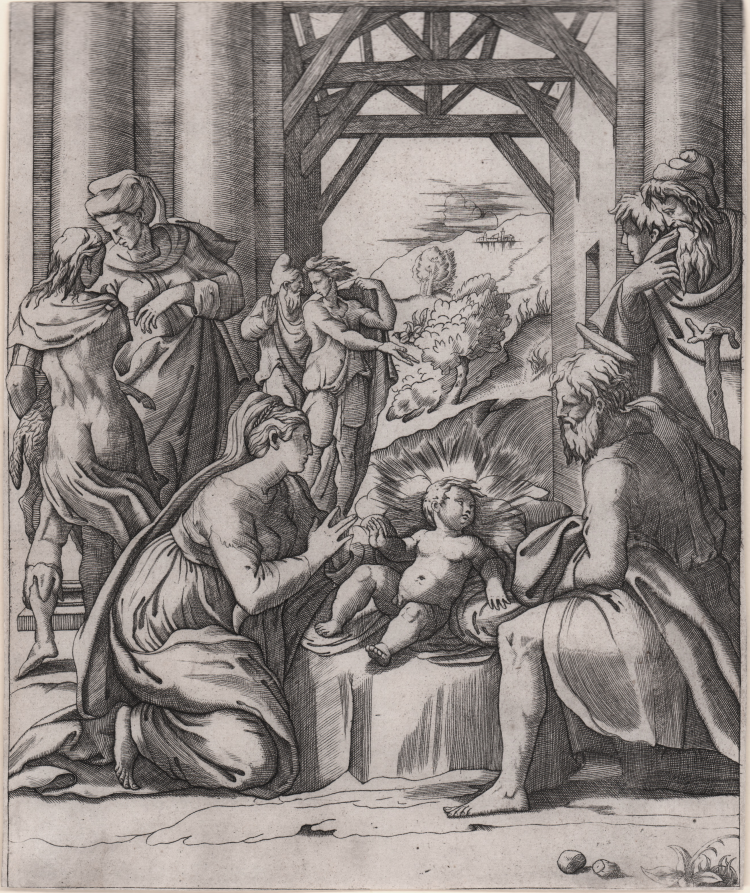



| Reference: | S11338 |
| Author | Enea VICO |
| Year: | 1540 ca. |
| Measures: | 220 x 265 mm |


| Reference: | S11338 |
| Author | Enea VICO |
| Year: | 1540 ca. |
| Measures: | 220 x 265 mm |
Engraving, 1540 circa, without printing details.
Magnificent proof, printed on contemporary laid paper with “fleur-de-lys with circle” watermark, trimmed close to platemark, in very good condition.
The composition is based on a drawing by Parmigianino [Chatsworth, the Devonshire Collection (Popham, 1, p. 212, n. 732)].
The print, not in Bartsch, is attributed to Enea Vico by Phyllis Deaborn Massar, for the obvious stylistic analogies: “This note is in the form of a query. While inventorying the 275 prints in the Metropolitan Museum of Art's Mariette Album of prints by or after Parmigianino (inv. no. 27.78.2) I found three prints, so far unattributed, which I thought might be by Enea Vico (1520-70). I present my arguments here with the hope that some more expert eye than mine may be able to support my attributions or suggest more plausible ones. […] The Adoration of the Shepherds (27.78.2.6), 265 × 220 mm (sheet), engraving. The key to the author of this print may lie in an unrecorded signed print by Enea Vico in the British Museum, A Seated Woman Looking in a Mirror (W. 2-118*; fig. 161) 132 x 90 mm (trimmed to borderline) engraving and etching, signed on the tablet: 1543 /AEV, and inscribed FRANC. PARM. IN.. The Seated Woman print is directly comparable to the unattributed A Seated Woman and Two Children (Bartsch xv.47.3, TIB 28.47.3, Raimondi School, Fantastic Subjects). The seated pose, the treatment of the coiffure, costume, furniture and back- ground are extremely similar, and also recall numerous motifs in the Adoration. The kneeling figure of the Virgin is similar to the two seated female figures in the other two prints. Also comparable are the profiles and shading of the female protagonists, their draperies, coiffures, costumes and arm positions. The small stones and weeds in the foreground are often found in Vico's prints, as are the striated clouds. A Parmigianino drawing of the Adoration, in the same sense as this print, is in Chatsworth, the Devonshire Collection (Popham, 1, p. 212, no. 732, reproduced, III, pl. 241; see also C. C. Baubach, et al., Correggio and Parmigianino, London 2000, p. 129, cat. no. 83). The Woman with Two Children and the Adoration had been assigned to Girolamo Fagiuoli by Johannes Wilde in his thesis, 'Die Anfange der Italien-ischen Radierung', Vienna 1918 (see Popham, I, p. 14, n. 1), an attribution that I think can be discarded” (cfr. P. Dearborn Massar, Three prints by Enea Vico?, in “Print Quarterly”, p. 282).
A fine example of this very rare engraving.
Bibliografia
P. Dearborn Massar, Three prints by Enea Vico?, in “Print Quarterly”, 2007,3, p. 282, fig. 160 (attributed to Enea Vico).
Enea VICO (Parma 1523 - Ferrara 1567)
|
Enea, son of Francesco, was antique dealer, drawer, engraver and numismatist. He was born in Parma on January 29th, 1523, according to what Huber says. After the first school years in the city, and very likely after he made acquaintance with the works of Giulio Romano, Vico moved to Rome in 1541. He then worked for Tommaso Barlacchi, who also engraved with him a series of Grottesche, in 1542. In the classical atmosphere of Rome, Vico’s style developed according to that of Perin del Vaga and Francesco Salviati, but always with Parmigianino as main reference. Around the first half of the century and after studying the works of Marcantonio, Agostino Veneziano, Caraglio and Bonasone, Vico acquired his own, peculiar style which can be seen in his main works. From Rome Vico moved to Florence, where he worked for Cosimo I, and then went to Venice, in 1557. In 1563 he is already in Ferrara, working for Alfonso d’Este till his death in 1567.
|
Enea VICO (Parma 1523 - Ferrara 1567)
|
Enea, son of Francesco, was antique dealer, drawer, engraver and numismatist. He was born in Parma on January 29th, 1523, according to what Huber says. After the first school years in the city, and very likely after he made acquaintance with the works of Giulio Romano, Vico moved to Rome in 1541. He then worked for Tommaso Barlacchi, who also engraved with him a series of Grottesche, in 1542. In the classical atmosphere of Rome, Vico’s style developed according to that of Perin del Vaga and Francesco Salviati, but always with Parmigianino as main reference. Around the first half of the century and after studying the works of Marcantonio, Agostino Veneziano, Caraglio and Bonasone, Vico acquired his own, peculiar style which can be seen in his main works. From Rome Vico moved to Florence, where he worked for Cosimo I, and then went to Venice, in 1557. In 1563 he is already in Ferrara, working for Alfonso d’Este till his death in 1567.
|